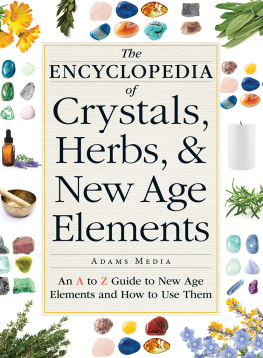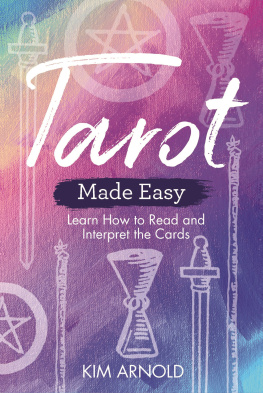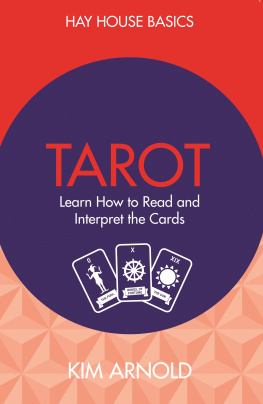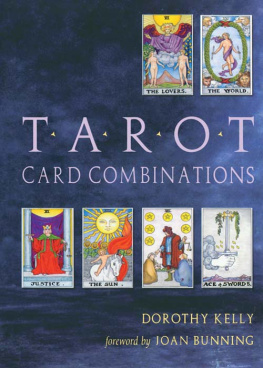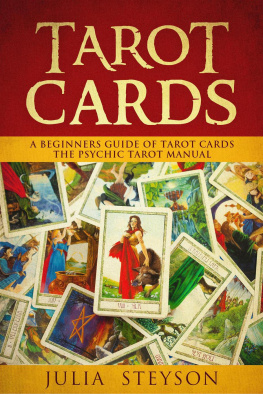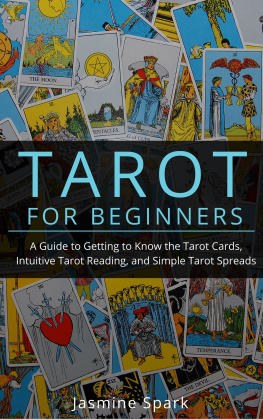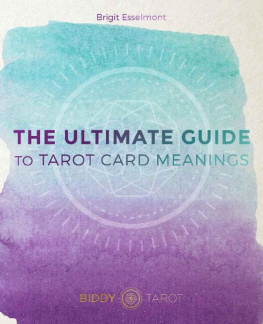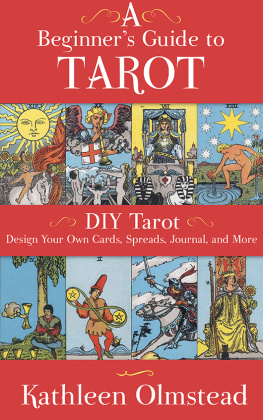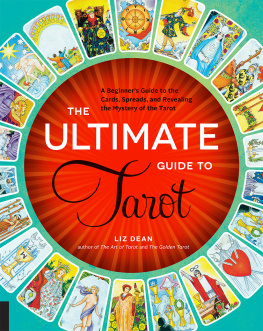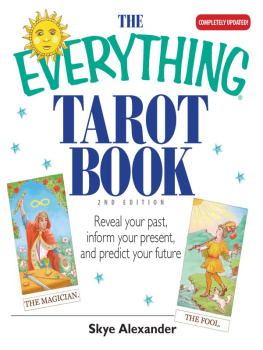How to Read Tarot
A Practical Guide

Avon, Massachusetts
Adams Media
An imprint of Simon & Schuster
57 Littlefield Street, Avon, MA 02322
www.adamsmedia.com
Copyright 2017 by Simon and Schuster
All rights reserved, including the right to reproduce this book or portions thereof in any form whatsoever. For information address Adams Media Subsidiary Rights Department, 1230 Avenue of the Americas, New York, NY 10020.
ADAMS MEDIA and colophon are trademarks of Simon and Schuster.
Contains material adapted from The Everything Tarot Book, 2nd Edition by Skye Alexander, copyright 2006 by Simon & Schuster, Inc., ISBN 10: 1-59337-656-1, ISBN 13: 978-1-59337-656-7.
Illustrations from the Rider-Waite Tarot Deck reproduced by permission of U.S. Games Systems, Inc., Stamford, CT 06902 USA. Copyright 1971 by U.S. Games Systems, Inc. Further reproduction prohibited. The Universal Waite Tarot Deck is a registered trademark of U.S. Games Systems, Inc.
Cover design by Stephanie Hannus.
Cover and interior images 123RF/Daria Solomennikova.
For information about special discounts for bulk purchases, please contact Simon & Schuster Special Sales at 1-866-506-1949 or .
The Simon & Schuster Speakers Bureau can bring authors to your live event. For more information or to book an event contact the Simon & Schuster Speakers Bureau at 1-866-248-3049 or visit our website at www.simonspeakers.com .
Library of Congress Cataloging-in-Publication Data
How to read tarot.
Avon, Massachusetts: Adams Media, 2017.
Includes index.
LCCN 2016042025 | ISBN 9781507201879 (pb) | ISBN 1507201877 (pb) | ISBN 9781507201886 (ebook) | ISBN 1507201885 (ebook)
LCSH: Tarot.
LCC BF1879.T2 H68 2017 | DDC 133.3/2424--dc23
LC record available at https://lccn.loc.gov/2016042025
ISBN 10: 1-5072-0187-7
ISBN 13: 978-1-5072-0187-9
eISBN 10: 1-5072-0188-5
eISBN 13: 978-1-5072-0188-6
Many of the designations used by manufacturers and sellers to distinguish their products are claimed as trademarks. Where those designations appear in this book and Simon & Schuster, Inc., was aware of a trademark claim, the designations have been printed with initial capital letters.
Introduction
Reading Tarot cards is an ancient art. For centuries Tarot cards have been used as a way to interpret the self and predict the future. And you, too, can learn to read these mystical cards with just a bit of practice and some background knowledge. How to Read Tarot will show you how to interpret and understand the meaning behind Tarot cards. Youll find everything from explanations of each card in the deck to how to use the Tarot for personal and spiritual growth. Above all, youll learn how to use the Tarot to discover your authentic self.
Your interpretation skills will grow with practice, so this guide provides you with information on over a dozen Tarot card spreadsgroupings of cardsthat you can use in a variety of ways to answer your questions. The more readings you do, the better you will become at sensing what the Tarot cards are trying to tell you.
As you become more familiar with the Tarot youll find it easier to understand the cards and to detect patterns in them. The more you study and practice the Tarot, the deeper your understanding becomes and the more the cards will resonate to your inner life as well as to events in your outer life.
Now lets begin our journey through the wondrous and powerful wisdom of the Tarot.
Part 1
The Basics of Tarot
Chapter 1
An Introduction to Tarot
For centuries, the Tarot has been used to see into the future and to gain advice on practical matters, such as a job, a marriage, or economic issues. Even today, these are perhaps its most common uses. But the Tarot can also serve as a tool to deepen your understanding of yourself, to enrich your relationships with other people, and to strengthen your connection with your Higher Self. Before you can begin your journey into reading Tarot cards it is important to know the history of the Tarot and also the practical matters of handling and caring for the special cards that you will use to stimulate your intuition and uncover the answers to the questions you have been pondering.
History of the Tarot
Many theories abound about the Tarots beginnings. One is that the great library of Alexandria in Egypt, whose female librarian Hypatia was world-renowned for her wisdom and learning, housed scrolls containing all the knowledge of the ancient world. Among these scrolls was the legendary Book of Thoth, derived from the mystery schools of ancient Egypt. The allegorical illustrations on Tarot cards are said to contain these secret teachings, which in the Major Arcana represent a course in personal and spiritual development. The Minor Arcana, which was added to the Tarot at a later date, may have derived from an Italian card game known as tarrochi. Our present-day poker decks closely resemble the Minor Arcana of the Tarot.
The oldest surviving Tarot cards are from fifteen incomplete decks painted in the fifteenth century for the Visconti-Sforza family. These incomplete sets are referred to collectively as the Visconti-Sforza Tarot. No complete deck has survived, some sets have a few face cards, and some consist of only one card. The decks were all commissioned by the Duke of Milan, Filippo Visconti, and then later his son-in-law and successor Francesco Sforza.
Tarot images are inextricably linked to ancient beliefs, mythologies, and religious systems such as the Hebrew Kabbalah. The cards numerological associations have been tied to the Greek mathematician Pythagoras, who taught that letters and numbers contain divine essence and extraordinary powers unrealized by the uninitiated.
Gypsies may have carried the cards to Europe. (The term gypsy is considered to be a corrupt form of the word Egyptian.) The Catholic Church, however, believed the Tarot was the devils picture book, and the cards were quickly condemned as heretical. To possess them was dangerous. Thus, during the Middle Ages, the Tarot went underground, along with astrology and many other forms of occult knowledge. (Occult simply means hidden.) Yet, despite persecution, the ancient knowledge contained in the Tarot continued to be passed down in secret, until interest in the cards surfaced again during the Renaissance.
Though we may never know their true history, we can still use Tarot cards to advise and guide us, to show us what lies ahead in the future, and to help us gain access to our inner knowing and the Divine. The amazing insights contained in the Tarot and the decks inherent flexibility make it just as relevant to contemporary Westerners as it was to the ancients.
Early Tarot Decks
No one knows exactly where or when the Tarot deck originated. Evidence suggests that seventy-eight-card Tarot decks, much like the ones were familiar with today, may have been used in Italy and France during the Renaissance for telling fortunes. During this period, the nobility in Milan used the Tarot for gaming and gambling.
Its believed that the first Tarot decks contained only the Major Arcana; the Minor Arcana were added later. Early packs portrayed people solely on the Major Arcana and Court cards. The numbered or pip cards showed only the suits symbolCups, Swords, Wands, or Pentaclesin the corresponding quantity (One through Ten). Some decks didnt even include labels on the Major Arcana cardsperhaps because novices were discouraged from doing readings and adepts would recognize the symbolism without needing labels.







